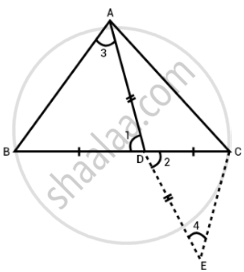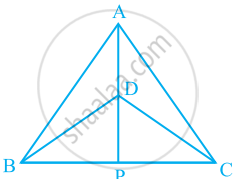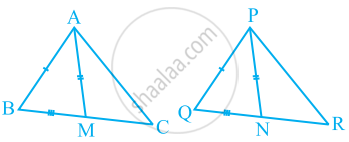Advertisements
Advertisements
प्रश्न
Prove that sum of any two sides of a triangle is greater than twice the median with respect to the third side.
उत्तर
Given: In triangle ABC with median AD,
To proof: AB + AC > 2AD
AB + BC > 2AD
BC + AC > 2AD
Producing AD to E such that DE = AD and join EC.
Proof: In triangle ADB and triangle EDC,
AD = ED ...[By construction]
∠1 = ∠2 ...[Vertically opposite angles are equal]
DB = DC ...[Given]
So, by SAS criterion of congruence]
ΔADB ≅ ΔEDC
AB = EC ...[CPCT]
And ∠3 = ∠4 ...[CPCT]
Again, in triangle AEC,
AC + CE > AE ...[Sum of the lengths of any two sides of a triangle must be greater than the third side]
AC + CE > AD + DE
AC + CE > AD + AD ...[AD = DE]
AC + CE > 2AD
AC + AB > 2AD ...[Because AB = CE]
Hence proved.
Similarly, AB + BC > 2AD and BC + AC > 2AD.
APPEARS IN
संबंधित प्रश्न
ABC is a right angled triangle in which ∠A = 90° and AB = AC. Find ∠B and ∠C.
ΔABC and ΔDBC are two isosceles triangles on the same base BC and vertices A and D are on the same side of BC (see the given figure). If AD is extended to intersect BC at P, show that
- ΔABD ≅ ΔACD
- ΔABP ≅ ΔACP
- AP bisects ∠A as well as ∠D.
- AP is the perpendicular bisector of BC.

AD is an altitude of an isosceles triangles ABC in which AB = AC. Show that
- AD bisects BC
- AD bisects ∠A
Two sides AB and BC and median AM of one triangle ABC are respectively equal to sides PQ and QR and median PN of ΔPQR (see the given figure). Show that:
- ΔABM ≅ ΔPQN
- ΔABC ≅ ΔPQR

In two right triangles one side an acute angle of one are equal to the corresponding side and angle of the other. Prove that the triangles are congruent.
Prove that in a quadrilateral the sum of all the sides is greater than the sum of its diagonals.
Two lines l and m intersect at the point O and P is a point on a line n passing through the point O such that P is equidistant from l and m. Prove that n is the bisector of the angle formed by l and m.
Line segment joining the mid-points M and N of parallel sides AB and DC, respectively of a trapezium ABCD is perpendicular to both the sides AB and DC. Prove that AD = BC.
ABCD is a quadrilateral such that diagonal AC bisects the angles A and C. Prove that AB = AD and CB = CD.
ABCD is quadrilateral such that AB = AD and CB = CD. Prove that AC is the perpendicular bisector of BD.
